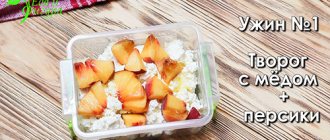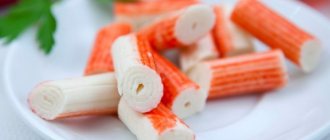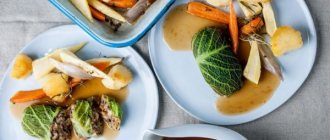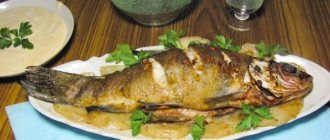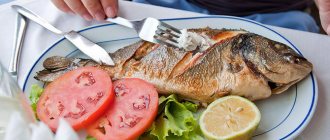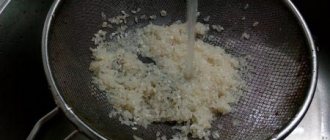Today, the economic situation in most of society has its own characteristic features:
- the possibility of buying a home, mainly with a mortgage (which many people use);
- the great needs of each person and the ability to satisfy them due to the diverse supply of the market, but since not many earn enough, the credit system has spread.
Therefore, most people may experience financial difficulties. Then it becomes necessary to tighten the belt. In such cases, one of the lifelines is an economical menu. It will help you save money and at the same time eat tasty, satisfying and even healthy.
Let's look at one menu as an example, and then talk about general recommendations for economical nutrition.
Economical menu for the week
Below is a menu for the week indicating the serving size and its calorie content per person.
| Day of the week | Eating | Dish | Portion volume | Calorie content |
| Monday | Breakfast | Milk rice porridge | 150 gr | 225 |
| Lunch | Glass of tea | 200 ml | 60 | |
| 3 sandwiches (bread, butter, cheese) | 150 gr | 300 | ||
| Dinner | Sauerkraut borscht | 300 gr | 250 | |
| Afternoon snack | Cottage cheese with sugar and sour cream | 200 gr | 200 | |
| Dinner | Vegetable stew | 200 gr | 300 | |
| Pork sauce | 100 gr | 355 | ||
| Second dinner (2-3 hours before bedtime) | A glass of kefir | 250 gr | 75 |
| Tuesday | Breakfast | Oatmeal | 150 gr | 205 |
| Lunch | A glass of kefir | 250 ml | 75 | |
| Cookies “warm milk” 4 pcs | 80 gr | 95 | ||
| Dinner | Sauerkraut borscht | 250 gr | 390 | |
| Afternoon snack | Baked apple | 180 gr | 80 | |
| Dinner | Rice | 150 gr | 226 | |
| Vegetable salad | 200 gr | 300 | ||
| Second dinner (2-3 hours before bedtime) | Vegetable salad (cucumber, tomato, pepper) | 130 gr | 195 |
| Wednesday | Breakfast | Milk buckwheat porridge | 150 gr | 300 |
| Lunch | Glass of tea | 200 ml | 60 | |
| 3 sandwiches (bread, butter, cheese) | 150 gr | 300 | ||
| Dinner | Cabbage soup with fresh cabbage | 300 gr | 250 | |
| Afternoon snack | Banana | 200 gr | 200 | |
| Dinner | Mashed potatoes | 150 gr | 195 | |
| Cutlet | 100 gr | 200 | ||
| Second dinner (2-3 hours before bedtime) | Glass of fermented baked milk | 200 gr | 160 |
| Thursday | Breakfast | Milk soup with rice | 250 gr | 400 |
| Lunch | Glass of fermented baked milk | 250 ml | 160 | |
| Cookies 4 pcs | 80 gr | 95 | ||
| Dinner | Cabbage soup with fresh cabbage | 250 gr | 220 | |
| Afternoon snack | Pear | 130 gr | 50 | |
| Dinner | Pasta with cheese | 150 gr | 300 | |
| 2 pickled cucumbers | 200 gr | 60 | ||
| Second dinner (2-3 hours before bedtime) | 2 fresh carrots | 100 g5 | 80 |
| Friday | Breakfast | Fried eggs | 130 gr | 260 |
| Lunch | Millet porridge | 150 ml | 250 | |
| Cookies 4 pcs | 80 gr | 95 | ||
| Dinner | Chicken noodle soup | 250 gr | 617 | |
| Afternoon snack | Cranberry juice and apple jam bun | 250 gr; 100 gr | 150; 200 | |
| Dinner | Buckwheat | 150 gr | 255 | |
| Beef liver goulash | 80 gr | 160 | ||
| Second dinner (2-3 hours before bedtime) | Beetroot salad with prunes | 200 gr | 140 |
| Saturday | Breakfast | Cottage cheese casserole | 150 gr | 200 |
| Lunch | Glass of tea | 200 ml | 60 | |
| 3 sprat sandwiches | 100 gr | 300 | ||
| Dinner | Chicken noodle soup | 250 gr | 617 | |
| Afternoon snack | Fruit salad (apple, pear, tangerine, yogurt) | 200 gr | 300 | |
| Dinner | French potato | 250 gr | 650 | |
| 80 gr | 160 | |||
| Second dinner (2-3 hours before bedtime) | A glass of kefir | 250 gr | 75 |
| Sunday | Breakfast | Fried egg with tomatoes | 150 gr | 280 |
| Lunch | Semolina | 150 ml | 300 | |
| 100 gr | 300 | |||
| Dinner | Rassolnik | 250 gr | 615 | |
| Afternoon snack | Milkshake with berries | 250 gr | 200 | |
| Dinner | Pilaf | 150 gr | 4000 | |
| Second dinner (2-3 hours before bedtime) | Apple | 180 gr | 80 |
What to have for dinner
No matter what they say, for us dinner is the heartiest meal of the day. The whole family gets together and chats over a delicious meal. Let it be so, but it would be good to follow a few rules:
- When you are thinking over a menu for your family for the week, remember that dinner is advised to be protein-based, the ideal combination is meat plus vegetables.
- Do not make portions large so that no one overeats at night.
- “Cut down” the feast three hours before bedtime.
Liver Stroganoff style
A simple and budget menu may include liver dishes. This offal is cheaper than meat, and surpasses it in vitamin content.
You will need:
- 500 g of any liver;
- 1 onion;
- 1 tbsp. l tomato paste;
- 2 tbsp. l sour cream;
- 1 tbsp. l flour;
- salt to taste.
Cut the onion into cubes and fry in sunflower oil until golden brown.
Add flour, tomato paste, sour cream to the onion and mix everything thoroughly over low heat. If the sauce is very thick, you can add a little water.
Salt and pepper the sauce, remove the pan from the stove.
We wash the liver, clean it, cut it into small pieces and fry in vegetable oil for 10-15 minutes.
Combine the liver with the sauce and mix.
Buckwheat, rice, bulgur, and potatoes are perfect as a side dish.
Pollock casserole
You will need:
- 700 g pollock;
- 3 potatoes;
- 2 carrots;
- 2 onions;
- 2 eggs;
- 250 g sour cream;
- 300 g cheese;
- to taste: salt and ground black pepper.
We defrost the fish, wash it, remove the entrails, black films, skin, and backbone.
We cut fish fillets, onions, carrots into pieces - grind it all using a meat grinder or blender.
Salt and pepper the resulting minced fish.
Cut the potatoes into thin slices and throw them into salted boiling water - cook for 7 minutes under the lid.
At this time we do the filling. Grate the cheese on a coarse grater, add eggs and sour cream. Mix everything thoroughly.
Grease a baking dish with butter and place the potato slices on it in an even layer. Then we make a layer of minced fish.
Fill everything with the cheese mixture.
Place the casserole in the oven for 40 minutes, temperature - 180 degrees.
Chicken baked with potatoes and dried fruits
You will need:
- 1 chicken carcass;
- 10 potatoes;
- 300 g of a mixture of any dried fruits (dried apricots, prunes, raisins, cherry plum, yellow plum);
- 80 g butter;
- salt to taste.
Wash dried fruits; if there are seeds, remove them. Soak in warm water.
At this time, wash the chicken and rub it with salt.
We stuff the chicken with dried fruits, “close” it with toothpicks, place it on a baking sheet, and place small pieces of butter on top.
Peel the potatoes, salt them and place them entirely on a baking sheet. Place a piece of butter on each potato.
We bake all this beauty for about an hour and a half at a temperature of 180 degrees.
Weekly grocery list
1. Pork (1 kg) 350 rubles 2. Minced beef (1 kg) 280 rubles 3. Chicken soup set (200 gr.) 60 rubles 4. Beef liver (400 gr.) 75 rubles 5. Rice (1 package ) 60 rubles 6. Oatmeal (1 package) 35 rubles 7. Buckwheat (1 package) 70 rubles 8. Millet (1 package) 48 rubles 9. Semolina (1 package) 30 rubles 10. Pasta (1 package) 53 rubles 11 Vermicelli (1 package) 30 rubles 12. Eggs (10 pcs.) 60 rubles 13. Sprats (1 package) 90 rubles 14. Potatoes (2 kg) 40 rubles 15. Cucumbers (2 fresh \ 3 salted) 70 rubles 16. Bell pepper (1 piece) 30 rubles 17. Fresh tomatoes (3 medium pieces) 140 rubles 18. Beets (2 medium ones) 10 rubles 19. Carrots (4 medium ones) 20 rubles 20. Apples (2 pieces) 50 rubles 21 . Bananas (2 pcs.) 20 rubles 22. Pears (2 pcs.) 30 rubles 23. Cookies (2 packs) 60 rubles 24. Bread (2 rolls) 60 rubles 25. Milk (1 pack) 120 rubles 26. Cottage cheese ( 1 package) 170 rubles 27. Sour cream (1 jar) 80 rubles 28. Low-fat kefir (1 bottle) 70 rubles 29. Ryazhenka (1 package) 70 rubles 30. Butter (1 package) 120 rubles
The total cost of products on this list is 2401 rubles. It is designed to prepare food according to the above menu for a family of two adults.
And in our other article you can see a list of products for only 1000 rubles for a whole week, also for a family of 4 people
What the body needs in winter: myths and reality
So, it is generally accepted that nature itself destined us to eat more and more densely in the cold. This is partly true: it takes a lot of calories to warm the body, and the body itself, in preparation for the winter, tries to stock up on a layer of fat that will protect us from hypothermia. Does this mean that we need to overeat and, accordingly, buy more food?
If you work as a janitor or lumberjack - of course! In the cold, and even physical labor! But for the average city dweller, jumping into a warm car from a warm apartment and driving again to a warm office, there is no need to follow the call of nature. The energy consumption of an ordinary person who does not physically work increases slightly in winter, so everything eaten in excess of the usual diet will inevitably be deposited on the sides.
To saturate your body with vitamins, you need to eat vegetables and fruits. In winter, fruits and vegetables cost several times more than in summer and autumn. In general, is there any point in buying them?
- Let's start with the fact that winter cucumbers and tomatoes are simply tasteless. As they once said in advertising, “no taste, no color, no smell.”
- Secondly, for preservation they are treated with chemicals, otherwise how do they manage not to rot and wither for so long?
- Thirdly, of course, there are no vitamins there, literally at all. So it’s better to use this money to buy a good vitamin and mineral complex. The only way to preserve at least some benefit in vegetables and fruits is to freeze and preserve them. Sauerkraut, frozen berries, vegetable mixtures, and homemade juices work best for fortification.
- Fourthly, it is good for health to follow the principle of seasonality. That is, there is no need to buy those products for which it is not in season. Everything is clear here: tomatoes don’t grow in winter. Potatoes and cabbage too, but they taste great without chemicals, so as long as they are in their natural state, eat to your health.
- It’s not so simple with the principle of terrain. Adherents of the theory of “genetic” nutrition are convinced that people should consume those foods that grow in their habitat. Well, that is, all kinds of exotic things are not for us. I don’t know how scientifically substantiated this is, but the fact that it is definitely useful for the wallet is an undeniable fact. Although recent studies by Finnish scientists have proven that the beginning of mass production and consumption of dairy products in the country of Suomi gave rise to the incidence of allergies associated with lactase deficiency. It turns out that it is not typical for the Finnish body to feed on milk, so its nature was deprived of the enzymes necessary for this. So, apparently, there is some reasonable grain here.
General recommendations for economical nutrition for the week
Before you go to the store, you need to make a clear list of products needed to prepare dishes from the menu. There is no need to buy anything extra.
It is worth buying products in places where prices are really lower. The most profitable way is to go to the market (you can bargain) or a wholesale center. Promotions in stores are a great help. You must always keep an eye on them.
You need to go to the store for shopping purposefully, and not when you have to. And in order to avoid wasting money, you must be well-fed at this time.
Most people's main dishes are meat dishes, which are expensive. To save money, you can buy offal - liver, hearts, stomachs. In addition to their low price, when prepared well, they have a wonderful taste.
It is necessary to completely exclude fast food, hamburgers, sushi, and carbonated drinks from your diet. It is very expensive and unhealthy. You should also avoid going to cafes and restaurants (only on very special occasions can you afford such a luxury).
One piece of meat can be used to prepare two dishes. For example, boil a whole chicken or a bone with meat (it’s better to cook for a long time over low heat - this way the meat will be soft and very tasty). Use the broth to make soup. And clean the meat from the bones. Add some of it to the soup, the rest can be stewed with vegetables or made into goulash.
In order not to cause indignation among household members during the week, it is necessary to cook their favorite dishes or food with their preferred ingredient at least once. For example, make stew with potatoes for your husband on Monday, and bake fish with rice as a side dish for your son on Thursday.
For picky families, you can cook for several days at once. If you cook a large pot of soup, it can last for three days. This will save a lot of money on groceries and time for the housewife.
Many people love to buy juice in cardboard boxes and bottles, which is a very big waste of money. In addition, they contain many preservatives and dyes, which is why they are harmful to health. It will be useful and less expensive to cook compotes and fruit drinks yourself.
It should be taken into account that for breakfast you need to eat easily digestible dishes, for example, porridge. The highest calorie meal is lunch. Dinner should be between breakfast and lunch in terms of calorie content. It is advisable to eat more often, but in small portions. Therefore, the menu includes snacks - second breakfasts and dinners.
Eating tasty and healthy doesn’t mean it’s expensive! Eat healthy and be happy!
“50 kilograms of apples, 20 kilograms of watermelons, 40 kilograms of oranges”
“Everyone in our family is vegan - we don’t eat meat, fish, or dairy products. We eat simply - borscht, soups, spaghetti, salads, porridge cooked in a slow cooker, vegetables or legumes boiled, stewed or baked in the oven. The eldest daughter bakes various vegan pies. The one who is not busy cooks - mom, dad, older daughters. We have store-bought sweets, but children rarely eat them. But we always have a lot of fruit in our house and it is freely available. We prepare everything for one time, ready-made food is not heated and is not stored in the refrigerator. Our refrigerator contains only greens, sauerkraut and olives. We cooked it and ate it right away. If something is not eaten, it goes into the compost. We buy products in such quantities at a small wholesale base.”
***
Preparing this material has been extremely therapeutic for me. At some point, I realized that I was terribly tired of this closed cycle: buy, take home, cook, feed, wash dishes, buy again. It began to seem to me that all I did was go grocery shopping, carry bags home and cook, cook, cook. I am not as tired of any other household chore as I am of cooking. And all my friends, by the way, too. After comparing our grocery list and the scale of cooking with the interview subjects, I felt ashamed to whine and complain. So-so excuse, I agree. Everyone has their own pain, no matter how hard it is for others. But the main thing is that I received a powerful injection of inspiration, new ideas (breakfast on holiday mornings prepared by the hands of children, isn’t it great?) and new goals that I want to strive for (not reheating food, buying less sweets, preparing more vegetable dishes).
